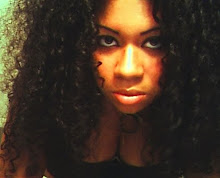Friday, April 3, 2009
The Goddess Maat...
Ma'at Mayet [Muh'aht]. Patron of truth, law & universal order. She is depicted as a woman wearing a crown surmounted by a huge ostrich feather. Her totem symbol is a stone platform or foundation, representing the stable base upon which order is built. Maat is the personification of the fundamental order of the universe, without which all of creation would perish. He primary duty of the pharoah was to uphold this order by maintaining the law & administering justice. To reflect this many pharoahs took the title 'Beloved of Maat', emphasizing their focus on justice & truth. At any event in which something would be judges Maat was said to be present, & her name would be invoked so that the judge involved would rule correctly & impartially. In the underworld, the heart of the deceased was weighed by Anubis (discuss in later post) against Maat's feather. If the heart was heavy with wicked deeds, it would outweigh the feather, & the soul would be fed to the demon AmmitBut if the scales were blanced, indicating that the deceased was just & honorable in life he would be welcomed by Osiris into the Blessed Land. Maat's presence in all the worlds was universal & all the Gods deferred to her. She was worshipped and revered widely throughtout all of Egypt. Even the Gods are depicted as praising her. Maat symbol is order. Goddes of truth, balance & order. Maat, unlike Hathor & Nephthys (later posts), seemed to be more of a concept than an actual goddess. The literal meaning of her name is 'truth'. She was truth, balance, justice, order personified. she was harmony and what was 'right'. She was what things should be. It was thought that if Maat didn't exist, the universe would be chaos once again. The Egyptians believed the univers was above everything else an ordered & rational place. It functioned with predictability & regularity. The cycles of yhe universe always remained constant. In the moral sphere purity was rewarded, sin was punished. Both mentally... And physically, the universe was in perfect balance. Egypt then was seen to be nothing without Maat. Maat was reality, the solid grounding of reality that made the Sun rise, the stars shine, the river flood & man think. The universe, all the world around them was sacred in the Ancient view. 'Ethics' is an issue of human permission. It is a function of the human world or duality. What is 'ethical' for one group is 'sin' for another. But Maat, the reality that made all groups what they are is transcendant of 'ethics', just as a rock or a flower is amoral, a-ethical, without 'truth of falsehood', how can a flower be false or ethical? It just IS. How can the universe be 'ethical or moral', right ir wrong? It simply IS. That is Maat. Despite being a winged goddess (like Nephythys), she was judge at the Egyptian underworld at the halls of Maat or the Halls of Double Maat. The dead person's heart was placed on a scale and balanced by Maat herself or the Feather of Maat. Thoth In other depictions, Thoth (God of writing & scribes) weighed the heart. If the deceased had been found to not have followed the concept of Maat during his life, his heart was devoured by a demon (Ammut-devouress of the dead) & died the final death. If the heart was equal to Maat, the deceased was allowed rto go to the afterlife. In life it ws the pharoahs duty to uphold Maat. 'I have done Maat' has been spoken by several pharoahs. The ruler who forcibly emphasizes his adherence to Maat on his monuments is Akhenaten--the very king whom later pharoahs considered to have deviated immensely from her laws. Maat was also the justice meted out in ancient Egyptical law courts. It is likely that a 'Priest of Maat' referred to people involved in the justice system, as well as being priests of the goddess herself. There is a small temple pf Maat (in ruins) at Karnak. The temple seems to have been built by Hathshepsut (later post) then reconstructed by Thutmose III. Maat did not exist until she rose ... From the waters of Nun (various gods & goddesses of Chaos). She was known as a Neter goddess & as such was described as a daughter of Ra. But without Maat, Egyptians believed Nun would reclaim the universe. She was also thought to be the wife of Thoth, moon god. God of wisdom. God of writing & scribes. To the Egyptian mind Maat bound all things together in an indestructable unity: the universe, the natural world, the state & the individual were all seen as parts of the order generated by Maat. Masculine coulterpart-Thoth. Attributes are the same. Seen to represent the *Logos of Plato* The Egyptians believed the soul resides within the heart... Logos (Logoi) of ancient Greek philosophy, mathematics, rhetoric, theophilosophy and Christianity.
Subscribe to:
Post Comments (Atom)

Beautiful
ReplyDelete